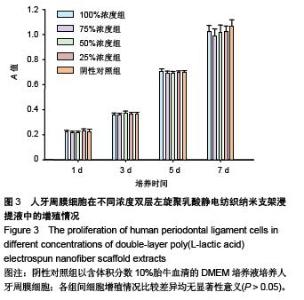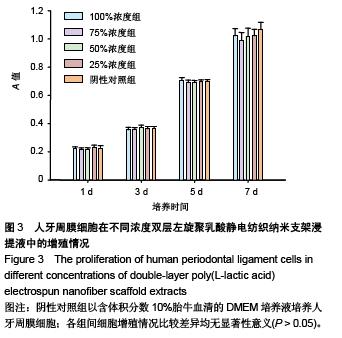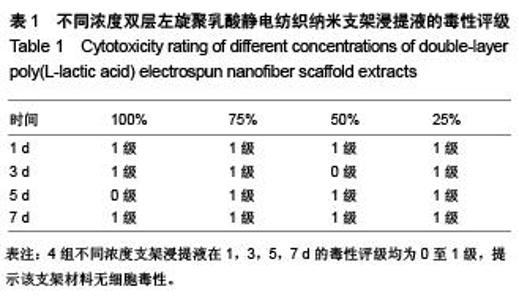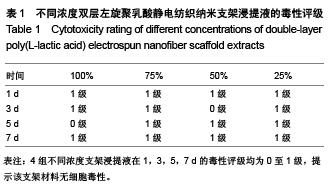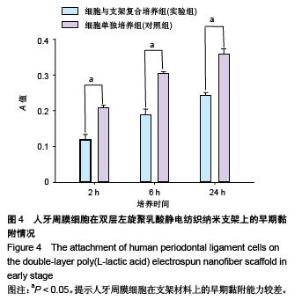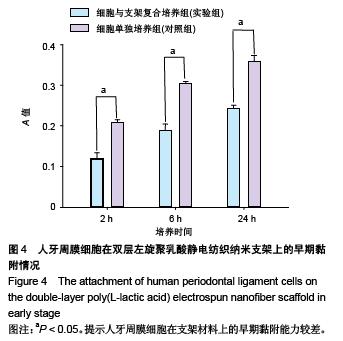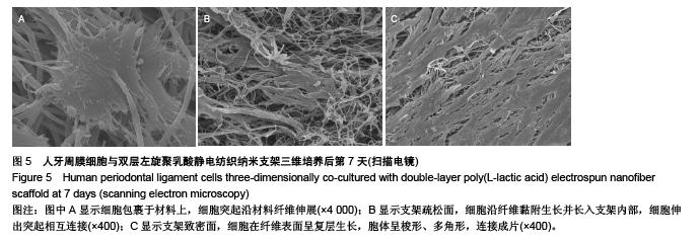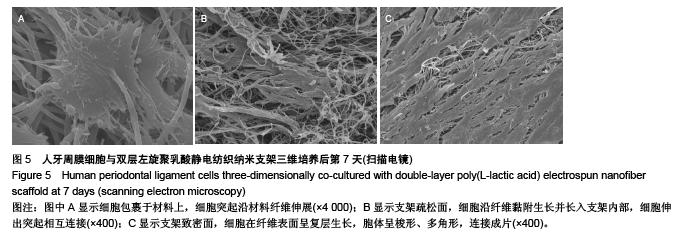Chinese Journal of Tissue Engineering Research ›› 2015, Vol. 19 ›› Issue (52): 8438-8483.doi: 10.3969/j.issn.2095-4344.2015.52.014
Previous Articles Next Articles
Biocompatibility of double-layer poly(L-lactic acid) electrospun nanofiber scaffold with human periodontal ligament cells
Sun Wen-juan, Jiang Hao-shun, Huang Nan-nan, Tang Qian, Yang Yu-hong
- Department of Stomatology, the Third Affiliated Hospital of Sun Yat-sen University, Guangzhou 510630, Guangdong Province, China
-
Received:2015-11-04Online:2015-12-17Published:2015-12-17 -
Contact:Tang Qian, Associate chief physician, Department of Stomatology, the Third Affiliated Hospital of Sun Yat-sen University, Guangzhou 510630, Guangdong Province, China
CLC Number:
Cite this article
Sun Wen-juan, Jiang Hao-shun, Huang Nan-nan, Tang Qian, Yang Yu-hong. Biocompatibility of double-layer poly(L-lactic acid) electrospun nanofiber scaffold with human periodontal ligament cells[J]. Chinese Journal of Tissue Engineering Research, 2015, 19(52): 8438-8483.
share this article
| [1] Parihar AS,Katoch V,Raiguru SA,et al.Periodontal Disease: A Possible Risk-Factor for Adverse Pregnancy Outcom.J Int Oral Health.2015;7(7):137-142. [2] Slots J.Periodontal herpesviruses: precalence, pathogenicity, systemic risk. Periodontol 2000.2015;69(1):28-46. [3] Leszczynska A,Buczko P,Buczko W,et al.Periodontal pharmacotherapy-an updated review. Adv Med Sci.2011; 56(2): 123-131. [4] Galler KM,D'Souza RN.Tissue engineering approaches for regenerative dentistry. Regen Med.2011;6(1):111-124. [5] Ivanovski S,Vaquette C,Gronthos S,et al.Multiphasic scaffolds for periodontal tissue engineering.J Dent Res.2014;93(12): 1212-1221. [6] 鲁红,田宇,吴织芬,等.牙周膜细胞松质骨基质支架复合移植促进牙周组织再生的研究[J]. 北京口腔医学,2012,20(4):185-189. [7] Tian Y,Bai D,Guo W,et al.Comparsion of human dental follicle cells and human periodontal ligament cells for dentin tissue regeneration. Regen Med.2015;10(4): 461-179. [8] 孙文娟,唐倩,黄南楠,等.双层胶原支架与人牙周膜细胞的体外生物相容性[J].中山大学学报:医学科学版,2014,35(2):250-255. [9] Mitra, T,Sailakshmi G,Gnanamani A,et al.Preparation and characterization of malonic acid cross-linked chitosan and collagen 3D scaffolds: an approach on non-covalent interactions.J Mater Sci Mater Med.2012;23(5):1309-1321. [10] Han P,Wu C,Chang J,et al.The cementogenic differentiation of periodontal ligament cells via the activation of Wnt/beta-catenin signalling pathway by Li+ ions released from bioactive scaffolds.Biomaterials.2012;33(27):6370-6379. [11] Wu C,Zhou Y,Lin C,et al.Strontium-containing mesoporous bioactive glass scaffolds with improved osteogenic/ cementogenic differentiation of periodontal ligament cells for periodontal tissue engineering. Acta Biomater.2012; 8(10): 3805-3815. [12] Chen FM,Jin Y.Periodontal tissue engineering and regeneration: current approaches and expanding opportunities.Tissue Eng Part B Rev.2010;16:219-255. [13] Schofer MD,Roessler PP,Schaefer J,et al. Electrospun PLLA nanofiber scaffolds and their use in combination with BMP-2 for reconstruction of bone defects. PLoS One.2011;6(9):e25462. [14] Zamparelli A,Zini N,Cattini L,et al.Growth on poly(L-lactic acid) porous scaffold preserves CD73 and CD90 immunophenotype markers of rat bone marrow mesenchymal stromal cells.J Mater Sci Mater Med.2014;25(10):2421-2436. [15] 魏兴,王香梅,张志军,等.静电纺丝技术在聚乳酸改性及应用中的作用[J].山西化工,2012, 32(2): 26-30. [16] Petrie Abrigo M,McArthur SL,Kingshott P,et al.Comparative effects of scaffold pore size, pore volume, and total void volume on cranial bone healing patterns using microsphere-based scaffolds.J Biomed Mater Res A.2009; 89(3):632-641. [17] Ingavle GC,Leach JK.Advancements in electrospinning of polymeric nanofibrous scaffolds for tissue engineering.Tissue Eng Part B Rev.2014;20(4): 277-293. [18] 张静,梅芳,蔡晴,等.牙周膜细胞在网格型与无纺型聚乳酸纳米纤维支架材料上体外培养的研究比较[J].中国生物医学工程学报, 2009,28(5):754-759. [19] 邵正仁,颜玲,陈卡娜. 改性聚乳酸与Schwann细胞的生物相容性研究[J].蚌埠医学院学报,2009,34(9):753-755. [20] Benatti BB,SHvefio KG,Cnsati MZ,et al.Physiological features of periodontal regeneration and approaches for periodontal tissue engineering using periodontal ligament cells. Biosci Bioeng.2007;103:1-6. [21] Zhang C, Li J, Zhang L,et al.Effects of mechanical vibration on proliferation and osteogenic differentiation of human periodontal ligament stem cells.Arch Oral Biol. 2012;57(10): 1395-1407. [22] Gottlw J,Nyman S,,Lindhe J, et al. New attachment formation in the human periodontium by guided tissue regeneration. Case reports. J Clin Peridontol. 1986; 13(6):604-616. [23] Bottino MC,Thomas V.Membranes for Periodontal Regeneration-A Materials Perspective. Front Oral Biol.2015; 17:90-100. [24] Slotte C, Asklöw B, Lundgren D.Surgical guided tissue regeneration treatment of advanced periodontal defects: a 5-year follow-up study. J Clin Periodontol.2007; 34(11): 977-984. [25] Nygaard-Østby P,Bakke V,Nesdal O,et al.Periodontal healing following reconstructive surgery: effect of guided tissue regeneration using a bioresorbable barrier device when combined with autogenous bone grafting. A randomized- controlled trial 10-year follow-up.J Clin Periodontol. 2010; 37:366-373. [26] Sculean A,Nikolidakis D,Schwarz F,et al.Regeneration of periodontal tissues: combinations of barrier membranes and grafting materials - biological foundation and preclinical evidence: a systematic review. J Clin Periodontol. 2008;35(8 Suppl): 106-116. [27] Mopur JM,Devi TR,Ali SM, et al. Clinical and radiographic evaluation of regenerative potential of GTR membrane (Biomesh) along with alloplastic bone graft (Biograft) in the treatment of periodontal intrabony defects.J Contemp Dent Pract.2013;14(3): 434-439. |
| [1] | Chen Ziyang, Pu Rui, Deng Shuang, Yuan Lingyan. Regulatory effect of exosomes on exercise-mediated insulin resistance diseases [J]. Chinese Journal of Tissue Engineering Research, 2021, 25(25): 4089-4094. |
| [2] | Chen Yang, Huang Denggao, Gao Yuanhui, Wang Shunlan, Cao Hui, Zheng Linlin, He Haowei, Luo Siqin, Xiao Jingchuan, Zhang Yingai, Zhang Shufang. Low-intensity pulsed ultrasound promotes the proliferation and adhesion of human adipose-derived mesenchymal stem cells [J]. Chinese Journal of Tissue Engineering Research, 2021, 25(25): 3949-3955. |
| [3] | Yang Junhui, Luo Jinli, Yuan Xiaoping. Effects of human growth hormone on proliferation and osteogenic differentiation of human periodontal ligament stem cells [J]. Chinese Journal of Tissue Engineering Research, 2021, 25(25): 3956-3961. |
| [4] | Sun Jianwei, Yang Xinming, Zhang Ying. Effect of montelukast combined with bone marrow mesenchymal stem cell transplantation on spinal cord injury in rat models [J]. Chinese Journal of Tissue Engineering Research, 2021, 25(25): 3962-3969. |
| [5] | Gao Shan, Huang Dongjing, Hong Haiman, Jia Jingqiao, Meng Fei. Comparison on the curative effect of human placenta-derived mesenchymal stem cells and induced islet-like cells in gestational diabetes mellitus rats [J]. Chinese Journal of Tissue Engineering Research, 2021, 25(25): 3981-3987. |
| [6] | Hao Xiaona, Zhang Yingjie, Li Yuyun, Xu Tao. Bone marrow mesenchymal stem cells overexpressing prolyl oligopeptidase on the repair of liver fibrosis in rat models [J]. Chinese Journal of Tissue Engineering Research, 2021, 25(25): 3988-3993. |
| [7] | Liu Jianyou, Jia Zhongwei, Niu Jiawei, Cao Xinjie, Zhang Dong, Wei Jie. A new method for measuring the anteversion angle of the femoral neck by constructing the three-dimensional digital model of the femur [J]. Chinese Journal of Tissue Engineering Research, 2021, 25(24): 3779-3783. |
| [8] | Meng Lingjie, Qian Hui, Sheng Xiaolei, Lu Jianfeng, Huang Jianping, Qi Liangang, Liu Zongbao. Application of three-dimensional printing technology combined with bone cement in minimally invasive treatment of the collapsed Sanders III type of calcaneal fractures [J]. Chinese Journal of Tissue Engineering Research, 2021, 25(24): 3784-3789. |
| [9] | Qian Xuankun, Huang Hefei, Wu Chengcong, Liu Keting, Ou Hua, Zhang Jinpeng, Ren Jing, Wan Jianshan. Computer-assisted navigation combined with minimally invasive transforaminal lumbar interbody fusion for lumbar spondylolisthesis [J]. Chinese Journal of Tissue Engineering Research, 2021, 25(24): 3790-3795. |
| [10] | Hu Jing, Xiang Yang, Ye Chuan, Han Ziji. Three-dimensional printing assisted screw placement and freehand pedicle screw fixation in the treatment of thoracolumbar fractures: 1-year follow-up [J]. Chinese Journal of Tissue Engineering Research, 2021, 25(24): 3804-3809. |
| [11] | Shu Qihang, Liao Yijia, Xue Jingbo, Yan Yiguo, Wang Cheng. Three-dimensional finite element analysis of a new three-dimensional printed porous fusion cage for cervical vertebra [J]. Chinese Journal of Tissue Engineering Research, 2021, 25(24): 3810-3815. |
| [12] | Wang Yihan, Li Yang, Zhang Ling, Zhang Rui, Xu Ruida, Han Xiaofeng, Cheng Guangqi, Wang Weil. Application of three-dimensional visualization technology for digital orthopedics in the reduction and fixation of intertrochanteric fracture [J]. Chinese Journal of Tissue Engineering Research, 2021, 25(24): 3816-3820. |
| [13] | Sun Maji, Wang Qiuan, Zhang Xingchen, Guo Chong, Yuan Feng, Guo Kaijin. Development and biomechanical analysis of a new anterior cervical pedicle screw fixation system [J]. Chinese Journal of Tissue Engineering Research, 2021, 25(24): 3821-3825. |
| [14] | Lin Wang, Wang Yingying, Guo Weizhong, Yuan Cuihua, Xu Shenggui, Zhang Shenshen, Lin Chengshou. Adopting expanded lateral approach to enhance the mechanical stability and knee function for treating posterolateral column fracture of tibial plateau [J]. Chinese Journal of Tissue Engineering Research, 2021, 25(24): 3826-3827. |
| [15] | Zhu Yun, Chen Yu, Qiu Hao, Liu Dun, Jin Guorong, Chen Shimou, Weng Zheng. Finite element analysis for treatment of osteoporotic femoral fracture with far cortical locking screw [J]. Chinese Journal of Tissue Engineering Research, 2021, 25(24): 3832-3837. |
| Viewed | ||||||
|
Full text |
|
|||||
|
Abstract |
|
|||||




